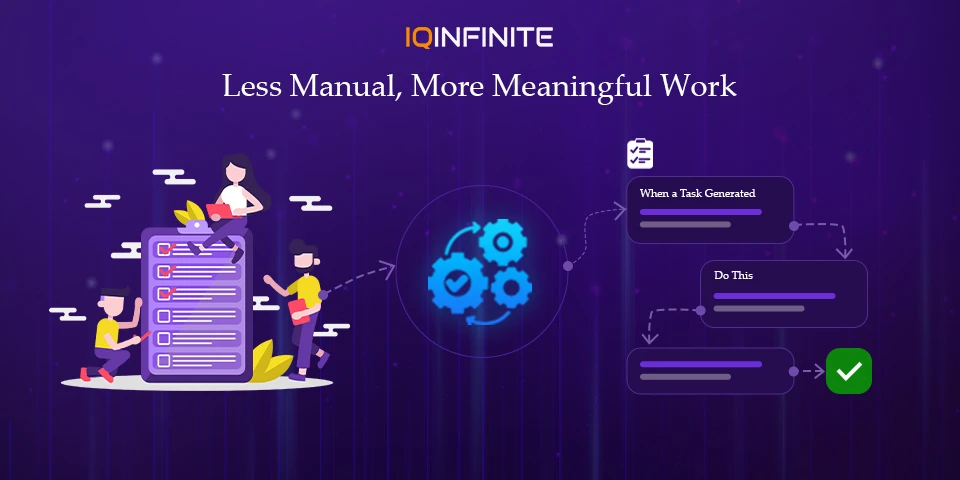From Manual Tasks to Automation: How Software Frees Teams to Focus on What Matters

In today’s fast-paced digital landscape, every minute counts. Teams across industries are constantly seeking ways to improve efficiency, reduce human error and spend more time on high-value work that drives growth. The answer? Automation.
Automation has evolved far beyond simple task scheduling. Modern software solutions can now handle everything from customer onboarding to data entry, analytics, marketing campaigns and even complex decision-making. Let’s explore how automation empowers teams to shift their focus from repetitive manual work to meaningful innovation and strategic growth.
1. The Cost of Manual Processes
Before automation, many teams spent hours sometimes days on tasks that, while essential, didn’t directly contribute to business innovation or customer satisfaction. Think about activities like:
• Updating spreadsheets
• Sending repetitive follow-up emails
• Logging customer data
• Generating reports
• Managing approvals and workflows manually
While these processes are crucial for operations, they often become productivity bottlenecks. According to McKinsey, employees spend up to 30% of their workweek on tasks that could be automated with existing technology. This not only drains time but also limits creativity and strategic thinking.
• Updating spreadsheets
• Sending repetitive follow-up emails
• Logging customer data
• Generating reports
• Managing approvals and workflows manually
While these processes are crucial for operations, they often become productivity bottlenecks. According to McKinsey, employees spend up to 30% of their workweek on tasks that could be automated with existing technology. This not only drains time but also limits creativity and strategic thinking.
2. The Rise of Intelligent Automation
Automation is no longer just about replacing manual work it’s about enhancing human capabilities. Intelligent automation combines technologies like Artificial Intelligence (AI), Machine Learning (ML) and Robotic Process Automation (RPA) to create smarter, self-learning systems that adapt over time.
For example:
• Marketing teams use AI-powered tools to segment audiences, personalize campaigns and analyse engagement in real time.
• Finance teams rely on automation to reconcile accounts, detect anomalies and ensure compliance effortlessly.
• HR departments automate onboarding, payroll and performance tracking, freeing up time for employee engagement and development.
These technologies don’t eliminate jobs they elevate them by allowing people to focus on problem-solving, innovation and customer relationships.
For example:
• Marketing teams use AI-powered tools to segment audiences, personalize campaigns and analyse engagement in real time.
• Finance teams rely on automation to reconcile accounts, detect anomalies and ensure compliance effortlessly.
• HR departments automate onboarding, payroll and performance tracking, freeing up time for employee engagement and development.
These technologies don’t eliminate jobs they elevate them by allowing people to focus on problem-solving, innovation and customer relationships.
3. The Real Benefits: Time, Accuracy and Morale
Here’s what businesses gain when they embrace automation:
1. Time Savings
Automation eliminates repetitive workflows, reducing turnaround times drastically. Tasks that once took hours can now be done in minutes giving teams more time for strategy and creativity.
2. Improved Accuracy
Humans are prone to fatigue and errors, especially with data-heavy or repetitive tasks. Automated systems ensure precision and consistency, reducing costly mistakes.
3. Employee Satisfaction
When employees no longer feel bogged down by monotonous work, morale soars. People feel more engaged when they can use their skills for meaningful contributions rather than administrative chores.
4. Scalability
Automation allows businesses to handle higher workloads without additional headcount. As companies grow, processes can scale effortlessly making automation a foundation for sustainable expansion.
1. Time Savings
Automation eliminates repetitive workflows, reducing turnaround times drastically. Tasks that once took hours can now be done in minutes giving teams more time for strategy and creativity.
2. Improved Accuracy
Humans are prone to fatigue and errors, especially with data-heavy or repetitive tasks. Automated systems ensure precision and consistency, reducing costly mistakes.
3. Employee Satisfaction
When employees no longer feel bogged down by monotonous work, morale soars. People feel more engaged when they can use their skills for meaningful contributions rather than administrative chores.
4. Scalability
Automation allows businesses to handle higher workloads without additional headcount. As companies grow, processes can scale effortlessly making automation a foundation for sustainable expansion.
4. Where to Begin: Steps Toward an Automated Future
Transitioning to automation doesn’t have to be overwhelming. Here’s a practical roadmap:
- Identify repetitive tasks: Start with processes that consume time but don’t require complex decision-making.
- Choose the right tools: Platforms like Zapier, UiPath, Asana or custom-built solutions can help depending on your business size and needs.
- Start small, scale gradually: Automate one process, measure results and then expand.
- Train your team: Ensure employees understand automation’s purpose to assist, not replace.
- Monitor and optimize: Continuously refine workflows as your organization and technology evolve.
5. The Future of Work Is Collaborative
The future of work isn’t about humans vs. machines it’s about humans and machines working together. Automation handles the routine, while people bring creativity, empathy and innovation to the table.
By embracing automation, companies unlock their team’s full potential. Instead of drowning in administrative tasks, employees can focus on what truly matters creating value, building relationships and driving growth.
By embracing automation, companies unlock their team’s full potential. Instead of drowning in administrative tasks, employees can focus on what truly matters creating value, building relationships and driving growth.
Conclusion
Automation isn’t just a technology shift it’s a mindset shift. It’s about empowering teams to spend less time managing processes and more time shaping the future.
As businesses continue to evolve, those who embrace automation early will lead the way more agile, more innovative and more human than ever before.
As businesses continue to evolve, those who embrace automation early will lead the way more agile, more innovative and more human than ever before.
